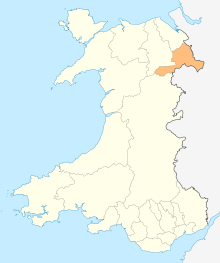Erddig
Erddig Hall (Welsh pronunciation: [ˈɛrðɪɡ]) is a National Trust property on the outskirts of Wrexham, Wales. Located 2 miles (3.2 km) south of Wrexham town centre, it was built in 1684–1687 for Josiah Edisbury, the High Sheriff of Denbighshire; it was designed in 1683 by Thomas Webb (d. 1699), a master mason of Middlewich, Cheshire.[1]
.jpg)
Erddig is one of the country's finest stately homes. In 2003, it was voted by readers of the Radio Times and viewers of the Channel 5 television series Britain's Finest Stately Homes as "Britain's second finest".[2] In September 2007 it was voted the UK's "favourite Historic House" and the "8th most popular historic site" in the UK by Britain's Best.[3] It is a Grade I listed building.
House and family history
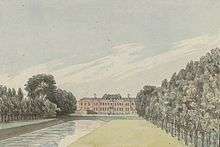
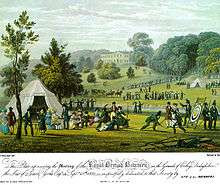
Caption: :This Plate representing the Meeting of the Royal British Bowmen on the Grounds of Erthig, Denbighshire, the Seat of Simon Yorke Esq. on Septr. 13th. 1822, is respectfully dedicated to that Society by ONE of its MEMBERS
Notice that both men and women members of the society have uniforms (the women's uniform was a green dress with yellow at the shoulder puffs and yellow triangles at the bottom hem). In the 1806 book Microcosm by William Henry Pyne, a number of these archery clubs are mentioned, along with a brief capsule history of both working and hobby archery.
The building was sold to the master of the Chancery, John Meller in 1714. John Meller refurbished and enlarged the house (including adding two wings in the 1720s), and, on his death in 1733 unmarried and childless, passed it to his nephew, Simon Yorke (d. 1767) (first cousin of Philip Yorke, 1st Earl of Hardwicke). The house was passed down through the Yorke family until March 1973, when the last squire Philip Scott Yorke gave it to the National Trust. This followed the collapse several years earlier of a shaft from the nearby coal mine (Bersham colliery) under the house, causing subsidence of 5 feet (1.5 m), which seriously affected the structural security of the house to the extent that, without suitable underpinning, it would have become a ruin. It was strengthened using the compensation of £120,000 the National Trust was able to extract from the National Coal Board. 63 acres (25 ha) of Erddig Park (out of view of the house) was subsequently sold for £995,000 and this paid for the restoration work on the house. The restoration was completed on 27 June 1977 when Charles, Prince of Wales officially opened Erddig to the public, joking that it was the first time in his, albeit short, life that he had opened something that was already 300 years old.
List Of Squires Yorke[4]
° Simon Yorke I (1696-1767), cousin of Philip Yorke, 1st Earl Of Hardwicke, maternal nephew of John Mellor
° Philip Yorke I (1743-1804), son of Simon Yorke I and his wife Dorothy Hutton
° Simon Yorke II (1771-1834), son of Philip Yorke I and his first wife Elizabeth Cust
° Simon Yorke III (1811-1894), son of Simon Yorke II and his wife Margaret Holland
° Philip Yorke II (1849-1922), son of Simon Yorke III and his wife Victoria Cust
° Simon Yorke IV (1903-1966), son of Philip Yorke II and his second wife Louisa Matilda Scott
° Philip Yorke III (1905-1978), brother of Simon Yorke IV
Tour of the mansion house
A tour of the house, which starts "below stairs", tells of the Yorke family's unusually high regard for their servants and, through a collection of portraits, photographs and verses (a family tradition started by Simon's son Philip Yorke (1743–1804), who published The Royal Tribes of Wales in 1799), provides a record of the people who lived and worked on the estate. In the staterooms "above stairs" there is a fine collection of 18th century furniture and other treasures (many of which originally belonged to John Meller, including a portrait in the Music Room of Judge Jeffreys, the "Hanging Judge"). The Yorke family seemingly never threw anything away and the house now has a unique collection ranging from the rare and magnificent (including some exquisite Chinese wallpaper in the State Bedroom) to the ordinary and everyday: indeed, one of the conditions that the last Squire, Philip S. Yorke (1905–1978) imposed on handing over the house and estate to the National Trust in 1973 was that nothing was to be removed from the house. He is quoted as saying: "My only interest for many years has been that this unique establishment for which my family have foregone many luxuries and comforts over seven generations should now be dedicated to the enjoyment of all those who may come here and see a part of our national heritage preserved for all foreseeable time."
General John Yorke (1814–1890) was to become from 1861, the owner of the distinctive Plas Newydd in Llangollen, the self-styled home of the famous Ladies of Llangollen.
Gardens
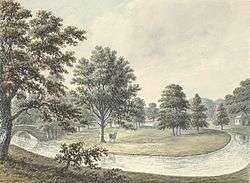
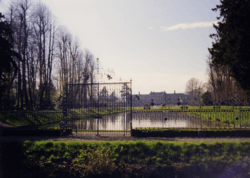
Erddig's walled garden is one of the most important surviving 18th century formal gardens in Britain. The gardens contain rare fruit trees, a canal, a pond, a Victorian era parterre, and are home to an NCCPG National Plant Collection of Hedera (ivy). There is also a fine example of gates and railings made by ironsmiths the Davies brothers, of nearby Bersham, for Stansty Park; the gates were moved to Erddig in 1908. The arrangement of alcoves in the yew hedges in the formal gardens may be a form of bee bole.
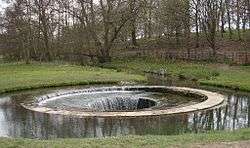
Estate buildings
The estate buildings include the joiners' shop and smithy, the Midden Yard (with its saw mill and cart sheds), and the Stable Yard (with its stables and tack room, carriages and vintage bicycles and vintage cars). In the house are the laundry, bakehouse, kitchen and scullery.
The nearby river supplied a source of water, which was pumped uphill by a hydraulic ram, the water entering the ram via a feature known as Erddig's Cup and Saucer.
Whilst occupied by the Yorke family the house was never installed with mains electricity, with the last Squire, Philip, relying on a portable generator to power his single television set. The saw mill, however, was equipped with its own static steam engine to provide the power for sawing and turning.
See also
Bibliography
- Griffiths, Eric (1995). Philip Yorke I (1743–1804), Squire of Erthig. Bridge Books. ISBN 1-872424-47-3.
- Waterson, Merlin (1980). The Servant's Hall. Pantheon Books. ISBN 0-394-50903-X.
References
- Colvin, Howard (1995). "Webb, Thomas". A Biographical Dictionary of British Architects, 1600–1840 (3rd ed.). Webb was named as 'measurer' in a contract of 1696 for building the chancel of the church at Aston-by-Sutton, Cheshire; he was buried 28 March 1699.
- "Erddig House and Gardens: Wales UK Holiday News". Wales.info. Retrieved 2012-03-07.
- "Britain's Best 2007: The winners". UKTV. 29 March 2007. Archived from the original on 18 November 2007. Retrieved 18 July 2016.
- Erddig National Trust Guidebook
